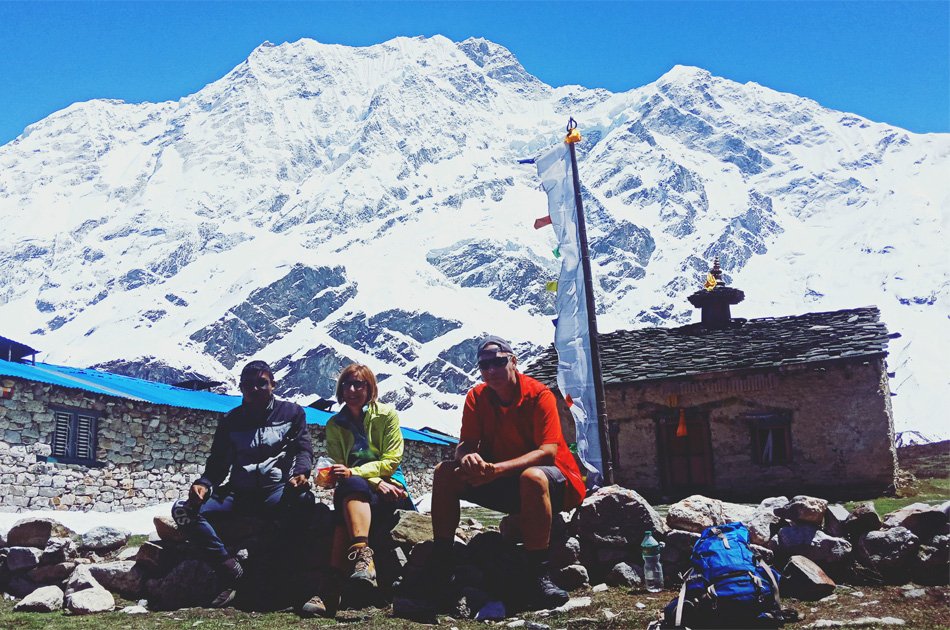14 Day Manaslu Circuit Trek Tour
The Manaslu region began welcoming visitors in 1991, and since then this area now becomes highly favourite among nature lovers on a global scale. In addition to this, today Manaslu region is the best option to its neighbour Annapurna Circuit; offering a range of rich biodiversity, stunning scenery, fantastic mountain views and heartwarming trails.
We begin our trek from the pretty village of Soti Khola heading north towards the Buri Gandaki valley; clinging to the river sometimes along the valley. But there’s steeper climbing to higher elevations as the trail meanders along the ever sloping, forested gorge. As we get to alpine heights, we soon come within view of majestic Mt. Manaslu at 8163m, the eight highest peak on earth.
The sight leaves us breathless! The highest altitude we get to when trekking Manaslu Circuit is the ‘Larkya La Pass’ at 5213m/17,103ft; a pass well known for its physical features throughout the Himalayas. Similar to all Travel Maker South Asia trips, we make sure trekkers have enough time to acclimatise on this journey with rest stops to visit the picturesque Tibetan villages of Sama Gaon and Samdo on the way.
Manaslu is rich in cultural diversity, and its extraordinary scenery with the fascinating flora and fauna all combine to make this region a hot destination for nature lovers shortly. This region is a restricted zone, and special permits get your entry. Equally, only organised trips are allowed in this area of Nepal.
Furthermore, teahouse lodges in the Manaslu region are pretty basic but cosy enough to keep you warm. Much of the trekking on Manaslu Circuit goes above 3000m, and proper body fitness is required; nevertheless, unique cultural diversity and jaw-dropping scenery keep you thrilled throughout the Odyssey.
- Pass through small villages of Soti Khola
- See the hot springs of Tatopani
- See people from the Sherpa community
- Cross over the Budhi Gandaki river to Samdo
- Head downstream of the Marshyangdi River to Tal
- A congratulatory and farewell dinner in Kathmandu
 Scheduling: Shared Tour
Scheduling: Shared Tour
 Languages offered on the Activity / Tour: English
Languages offered on the Activity / Tour: English
 Duration: 14 days
Duration: 14 days
 Printed or Mobile Voucher Accepted
Printed or Mobile Voucher Accepted A minimum of 2 adults per booking
A minimum of 2 adults per booking Not recommended for children under 16
Not recommended for children under 16 Pick-up servicePick up from your hotel in Thamel.
Pick-up servicePick up from your hotel in Thamel. Easy CancellationThere is no cancellation fee once Customers Cancel at least 7 day(s) prior to the date of the activity or tour.
Easy CancellationThere is no cancellation fee once Customers Cancel at least 7 day(s) prior to the date of the activity or tour.
There is 50% cancellation fee for Customers to Cancel 3 and 6 day(s) prior to the date of the activity or tour.
There is 100% cancellation fee for Customers to Cancel 2 day(s) prior to the date of the activity or tour.
 Confirmation will be received at time of booking
Confirmation will be received at time of booking
-
 Cut-off Time Available to be booked until 2 days before the tour starts. We reserve the option to confirm the tour or not due to availability.
Cut-off Time Available to be booked until 2 days before the tour starts. We reserve the option to confirm the tour or not due to availability.
- Insurance for guide and assistant.
- All food and accommodation for guide and assistant.
- Assistant guide for the group more than 4
- Well experienced English speaking guide.
- Basic emergency first aid kit.
- All breakfast, lunch and dinner during the trek.
- Descent Sleeping bag during the trek.
- Accommodation: on descent mountain lodge.
- All necessary government and local permits for the trek.
- All ground transportation from Kathmandu to trek point and to kathmandu by local bus.
- Tips for your guide and assistant.
- Your personal insurance, (it’s recommended to make insurance at least 40 days before the trek)
- All beverages including bottled water.
- your personal trekking gear.
- Your accommodation and food in Kathmandu (can be arranged on request)
After an early breakfast, we get moving early today for Sotikhola. In the course of the drive, we enjoy views of Nepalese rural life along with some lovely mountain scenery.
We will be driving on a tarred road from Kathmandu to Dhading Bensi, district headquarters of Dhading (1050m) but the drive from Dhanding Bensi to Arughat will be on a rough road.
On reaching Arughat, a major town in the region we drive further towards Sotikhola. Overnight at Soti Khola in a teahouse lodge.
The landscapes change as we go higher, the wide valley narrows and at times the trail cuts into the steep valley which is densely forested. Then we pass a number of small villages tucked into the hillside, until we reach a widening of this valley, on our opposite where a large tributary stream enters the Buri Gandaki.
The terraced farmland here belongs to the village of Lapbesi. We descend once again to the wider section, sandy Riverbank and follow a path, which runs below the steep, craggy valley path.
In the end, we have to climb up once again to get to Machhakhola, which has a number of teashops.
We cross over Machha Khola and head upstream to the tiny village of Khola Bensi and the hot springs at Tatopani. The whole valley here becomes steeper to the limits till the route to cross then switches to the left bank by a suspension bridge. The trekking trail is quite exposed and challenging in some places.
After a short section of forest trail, we reach a single teahouse at Doban. Above Doban village, the Buri Gandaki descends with some notable flowing of rapids. Beyond this hard steep section, the River is much more placid, meandering across a wide gravel bank and from Lauri, we will cross the River by hiking over an airy suspension bridge, and then climb on a high trail to the fields of Jagat for the night.
our hike today begins by climbing over a rocky ridge to Salleri, after which we descend to Sirdibas. The valley widens a bit as the trail continues up to Ghatta Khola.
We further continue walking upstream to a long suspension bridge in Philim, a large Gurung village. The trail turns north just above the lowest house in the village and stays on a fairly level trail as it crosses millet fields to Ekle Bhatti. The route now enters a steep, uninhabited gorge. At this point, we descend to the grassy land slopes, cross the Budhi Gandaki, then trek along the west bank for a while, then cross to the east bank and then back again.
As we continue through the trail the valley widens and we pass through bamboo forests to the Deng Khola. Upon crossing the Khola, we reach the tiny village of Deng. Overnight in Deng.
After a short hike beyond Deng, we cross the Budhi Gandaki and climb to Rana at 1910m. From the bridge, we climb a little to join a trail from Bhi, then head west up the Budhi Gandaki valley.
The trail also passes through forests and mani where we turn towards a corner that contours to Ghap. Even though there is another route, we take the route through Prok village. Prok village has a viewpoint for a beautiful sight of Siringi Himal. We further cross the Budi Gandaki several times today and come across several gompas en route.
The trail follows the river upstream through a dense forest. After crossing the river at a striking spot where it thunders down a narrow gorge, the forest becomes less dense and the trail is fine again. The pleasant walk continues and after a last steep climb we reach Namrung. Overnight in Namrung.
Namrung village offers a great viewpoint for Siring and Ganesh Himal and from the village one can also see Mt. Himal Chuli in the south. Following the lateral moraine of Pungen Glacier towards Sama, we reach the village and it takes a further 20 minutes to reach the monastery.
There are excellent views of Manaslu from here. In the afternoon, there are a number of possible walks to help your acclimatisation. There’s a monastery located on a ridge south of Sama Gaon. Today’s walk concludes in Samagaon where we spend the night.
We hang around at Samagaon for some much-needed rest and acclimatization. Today, we get familiar with the rich Sherpa culture. We enjoy the sight of thousands of mani stones with Buddhist texts and pictures and the Sherpa women clad in traditional clothes and ornaments.
On a little hill near the Sama village is an old Gompa (Pungyen Gompa), a monastery with great views of the glacier. It is named after Manaslu, Pungyen means ‘bracelet’, an ideal description of the two peaks. It was destroyed a year after the first unsuccessful Japanese attempt to climb Manaslu.
The locals believe that the climb angered the gods, and when the Japanese came back a year later they met with a lot of resistance that they had to give up their attempt. They were finally successful in 1959. Overnight in Samagaon.
Today finds us descending to the Budhi Gandaki River, that has turned north and follow it to a bridge over a side stream. The trail to the left leads to the Manaslu Base camp. The Larkya la Trail passes several mani walls as the valley begins to widen. It is an easy trail on a shelf above the river passing the juniper and birch forests of Kermo Kharka. We drop off the shelf, cross the Budhi Gandaki on a wooden bridge and climb steeply onto a headland between two forks of the river. From a stone arch we can view a large white kani. Finally passing through the kani we find Samdo. Overnight in Samdo
today sees us continuing our walk down the edge, crossing the wooden bridge over Budi Gandaki and begin walking upward.
on crossing two streams and witnessing the Larkya Glacier we go around the valley of the Salka Khola and climb up again to the stone guest house (4450m), which is not a lodge but a kind of shelter called Dharamshala, also known as Larke Phedi. The short walk today also leaves plenty of time for acclimatization and relaxing in the afternoon. Overnight in Dharmashala.
on completing a brief climb, we reach a valley on the north side of the Larkya Glaciers from where we can enjoy great views of Cho Danda and Larkya Peak.
Finally, we walk across moraines of the glacier, making a gradual ascent which becomes steeper only in the last section of the pass. From the pass, there are outstanding views of Himlung Himal, Cheo Himal, Kangguru and the huge Annapurna II. It is a longer day than usual to Bimtang, but to walk into these low pastures with the evening mist coming in with Mt. Manaslu looming close by is an awesome experience. Overnight in Bimthang.
after conquering heights and lengths of Larkya La, the trail today goes easy and normal. The trail to Tilje passes through paddy fields with moderate climbing.
The trail comes off the ridge in a big, sweeping arc to the river bank at 2580m. A short distance beyond is the village of Gho. Moving forward, we have to cross Karcha La pass and then the trail drops down through fig trees and rhododendron forests to Tilje.
Due to yesterday's tiredness, we might take an overnight rest at Gho but better lodges are available at Tilije.
Continuing our journey, we will head to Tal after we have our breakfast. A 5 hours walk goes through the trail downstream of Marshyangdi River. At the village, we go through a police checkpoint and continue to Dharapani.
We have entered the Annapurna circuit section from Dharapani. Further down, we come across Karte village and after quite a bit of walking we cross a bridge over Marshyangdi Khola.
We also come across some mani walls before reaching the village of Tal, situated at the foot of a large waterfall. Overnight in Tal.
We stick by the trail to Chyamje village crossing the Marshyangdi Khola once again.
The Marsyangdi valley opens with its terrace fields and villages clinging very high to the hillsides. The trail then descends through rhododendron and pine forests to Syange. Overnight in Syange.
The scenic cruise from Syange to Kathmandu via Besi Sahar offers a great opportunity to enjoy both hill and mountain landscapes.
The drive is often along the banks of the Marsyangdi and Trishuli rivers. We also drive by some beautiful villages with farming terraces on both sides of the road. In Kathmandu, we will be escorted to our hotel.
The day in Kathmandu can either be spent in leisure or perhaps we catch up with some last minute shopping. To celebrate the successful completion of our journey, we will have a farewell dinner in the evening accompanied by a cultural dance performed by the local belles. Overnight in Kathmandu.
- We would suggest you bring the following possessions for your journey : A book, camera, pack of cards, Headtorch/flashlight, toilet paper, multifunctional towel, water purification tablets, first aid kit, trekking stick, hiking shoes, water bottle, sleeping bag, winter jacket, thermal suit, gloves, sunglasses, hat, sunscreen, poncho/raincoat, backpack and extra plastic bags to make sure your important belongings (passport/money) are well secure.







 Product code: 3451
Product code: 3451  © Copyright 2024 Private Tour Inc. All Rights Reserved.
© Copyright 2024 Private Tour Inc. All Rights Reserved.